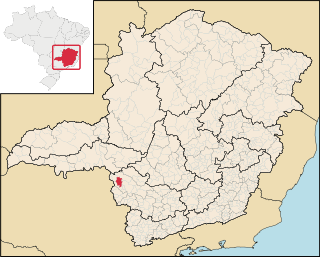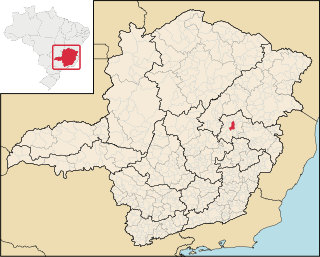Related Research Articles

Caxias do Sul is a city in Rio Grande do Sul, Southern Brazil, situated in the state's mountainous Serra Gaúcha region. It was established by Italian immigrants on June 20, 1890. Today it is the second largest city in the state of Rio Grande do Sul. In 2020, the population of Caxias do Sul was estimated at 517,451 people, many of whom are of Italian and German descent. The demonym of the citizens of Caxias do Sul is Caxiense.

Resende is a municipality in the Brazilian state of Rio de Janeiro. The population is 132,312 in an area of 1094 km2. Resendense refers to people or things that come from or inhabit Resende. It is the oldest town in this region, which has boundaries with the state of São Paulo and Minas Gerais. It is an important industrial, automotive, metallurgical, and tourist center, and headquarters of the world's second-largest military complex, the Academia Militar das Agulhas Negras (AMAN). Resende is of national importance and houses the Nuclear Fuel Factory complex of the "Indústrias Nucleares" of Brasil, the only one able to enrich uranium. Resende's automotive area holds MAN Latin America, the biggest truck and bus factory of Brazil, limited to PSA Peugeot Citroën and Michelin.

América Futebol Clube is a Brazilian football team from the city of Belo Horizonte, capital city of the Brazilian state of Minas Gerais. Founded in 1912, the club preserves its name and crest since its inception. The original home kit colours are white and green only; the black color was incorporated in the 1970s. The team also played with a red home kit between 1933 and 1942, as a protest to the introduction of professionalism. It hosts its matches at Independência stadium, being the only professional club in Belo Horizonte to have its own stadium. The club has the third largest fan base among the teams from Minas Gerais.

Mineiro, Mineirês, or the Brazilian mountain accent, is the Brazilian Portuguese term for the accent spoken in the heart of the state of Minas Gerais.

Lavras is a municipality in southern Minas Gerais state, Brazil. Located at an altitude of 919 m, it has a population of 98,602 inhabitants (2022). The area of the municipality is 564.495 km2. The average annual temperature is 19.6°C and the average annual rainfall is 1,511 millimetres.

Bernardo Joaquim da Silva Guimarães was a Brazilian poet and novelist. He is the author of the famous romances A Escrava Isaura and O Seminarista. He also introduced to Brazilian poetry the verso bestialógico, also referred to as pantagruélico — poems whose verses are very nonsensical, although very metrical. Under the verso bestialógico, he wrote polemical erotic verses, such as "O Elixir do Pajé" and "A Origem do Mênstruo". A non-erotic poem written in verso bestialógico is "Eu Vi dos Polos o Gigante Alado".

Mining in Brazil is centered on the extraction of iron, copper, gold, aluminum, manganese, tin, niobium, and nickel. About gemstones, Brazil is the world's largest producer of amethyst, topaz, agate and is a big producer of tourmaline, emerald, aquamarine, garnet and opal.
The Nova Iguaçu Volcano is located in the state of Rio de Janeiro, Brazil, in an area of volcanic rocks at the north-eastern border of the Mendanha massif. Klein and Vieira proposed the site to be an extinct volcano with a volcanic cone, volcanic crater, and volcanic bomb. Scientific journals have studied the volcanic geology of the area, identifying the rocks of volcanic appearance as constituted of subvolcanic intrusive rock bodies. The Nova Iguaçu volcano theory is now extinct in academic communities, but the myth continues in sightseeing promotion groups.

São João das Missões is a municipality in the north of the Brazilian state of Minas Gerais. As of 2020 the population was 13,125 in a total area of 675 km². The elevation is 501 meters. It became a municipality in 1997.

Cássia is a Brazilian municipality located in the center of the state of Minas Gerais. Its population as of 2020 was 17,740 people living in a total area of 643 km². The city belongs to the meso-region of Sul e Sudoeste de Minas and to the micro-region of Passos. It became a municipality in 1890.

Muzambinho is a municipality in the state of Minas Gerais in the Southeast region of Brazil.

São João Evangelista is a municipality in the state of Minas Gerais in the Southeast region of Brazil.

Peçanha is a municipality in the state of Minas Gerais in the Southeast region of Brazil.

Rio Preto is a municipality in the state of Minas Gerais in the Southeast region of Brazil.
Flausino Rodrigues Valle, better known as Flausino Vale was a Brazilian violinist/composer. Although he was a lawyer, he was a major researcher on Brazilian folk music. He was professor of History of Music at the Conservatório Mineiro de Música. Like Paganini, he had composed an album of 26 Preludes for solo violin in a Brazilian landscape style.

The Brazilian Election Justice was created by Decree No. 21,076 of 24 February 1932, representing one of the innovations of the Brazilian Revolution of 1930. In 1932 there was the first edited Brazilian Election Code, inspired by the Election Justice of the Czech Republic and the ideas of Joaquim Francisco de Assis Brasil, a politician, farmer and ambassador

Olímpio Mourão Filho was a Brazilian military officer known as the author of the Cohen Plan, a document used to justify the Estado Novo coup in 1937, and, ahead of the 4th Military Region/Infantry Division, as a precipitator of the 1964 coup d'état. He reached the rank of army general and ended his career presiding over the Superior Military Court from 1967 to 1969.

The Public Forces of the states of Brazil were already called "small states' armies" in the First Brazilian Republic (1889–1930) due to their martial character. They took part in the various struggles and rebellions of the period alongside, and sometimes against, the Brazilian Army. Their character was hybrid, police and warfare. They emerged in the federalism of the First Republic as shields of state power against central power, represented by the Army, and were dismantled by the federal government in the Vargas Era (1930–1945) onwards, losing their conventional warfare capabilities.
References
- ↑ II Congresso sobre Planejamento e Gestão das Zonas Costeiras dos Países de Expressão Portuguesa UFRGS - agosto/2015
- ↑ ANAIS do 31º Congresso Brasileiro de Espeleologia Cavernas.org - agosto/2015
- ↑ Jenner, Andrew (March 28, 2017). "Get Lost in Mega-Tunnels Dug by South American Megafauna". Discover. Kalmbach. Retrieved 16 April 2017.
- ↑ Casa de preguiça Archived 2015-05-15 at the Wayback Machine Ciência Hoje - agosto/2015
- ↑ Paleotocas, Crotovinas e Abrigos Subterrâneos Projeto Paleotoca - UFRGS - agosto/2015
- ↑ Lopes, Renato Pereira; Frank, Heinrich Theodor; et al. (15 Sep 2016). "Megaichnus igen. nov.: Giant Paleoburrows Attributed to Extinct Cenozoic Mammals from South America". Ichnos. 24 (2): 133–145. doi:10.1080/10420940.2016.1223654. hdl: 11449/162902 .
- ↑ Caverna escavada por mamíferos gigantes é descoberta na Amazônia O Globo- agosto/2015
- ↑ Parque Nacional é criado em Minas Gerais, mas deixa área de Mata Atlântica desprotegida Rede Sustentabilidade.org- agosto/2015
- ↑ O protagonista: um tatu gigante Boletim BR 116 - agosto/2015
- ↑ "Revista Espeleotema" (PDF). 2012.
- ↑ VICROSKI, Fabricio J. Nazzari; FRANK, Heinrich Theodor (2013). "A Problemática das Galerias Subterrâneas na Arqueologia do Sul do Brasil". Anais Eletrônicos do II Congresso Internacional de História Regional.
- ↑ AZEVEDO, Leonardo Waisman de Azevedo; COPÉ,Silvia Moehlecke. "A Gênese das Galerias Subterrâneas no Planalto Sul-Brasileiro". Revista de Arqueologia. Archived from the original on 2015-12-22. Retrieved 2017-04-02.